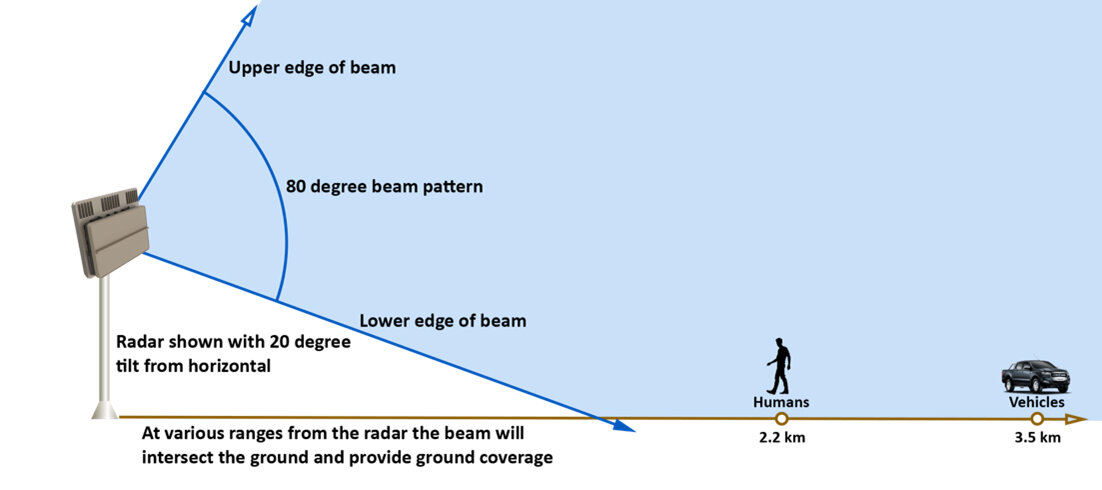The 21st Century Radar Solution for 21st Century Security Requirements
Electronically Scanned Array (ESA) radars are the gold standard of sensors. They are ultra-fast, high-resolution, long-range, and all-weather. They are also very expensive, large, heavy, and maintenance intensive.
Until recently, ESA radars could be divided into two categories: Passive Electronically Scanned Array (PESA) whose technology dates to World War II, and Active Electronically Scanned Array (AESA) whose technology dates to the 1960s.
We now have a 21st century solution to these old and outdated technologies. The Metamaterial Electronically Scanned Array (MESA) allows for ESA performance at a significantly lower size, weight, power consumption, and cost.
The iXero Rapid Deployment Radar System (iRDRS) employs the premier mid-range radar for robust 3D security solutions. It detects and tracks targets in both air and ground domains with high accuracy, and with the rich data output it can precisely slew industry-leading optical sensors to locate and identify the target.
Seamless Integration
At a facility or critical infrastructure location the iXero Rapid Deployment Radar System (iRDRS) is designed to integrate quickly and seamlessly with the iXero's Installation Security Operations Center (iSOC) or with an existing security facility. The iRDRS becomes a holistic part of your security architecture, capitalizing on and enhancing its capabilities.
iRDRS Tracking Ranges
The iXero Rapid Deployment Radar System (iRDRS) is the single solution that will meet your needs for tracking air and ground-based threats. In the past, security solutions primarily concentrated on threats approaching from ground level, but with the rapid introduction and proliferation of drones in our secure spaces, this must change.
With drones turning the 2D security space into 3D security space, we must rethink our approach to keeping our facilities safe. iRDRS is the best solution for defending our perimeters against threats that can endanger our employees and facilities.
iRDRS provides detection and tracking data packets operators can use to selectively focus on aerial targets of interest. The user can filter targets by range, velocity, and estimated Radar Cross-Section (RCS). Signatures for drones can be observed through micro-doppler and doppler smearing inherent in the returns for those intruder types.
iRDRS versatility allows the same array to perform ground search and air search missions simultaneously; this means the radars installed for aerial intrusion systems can also provide ground-detection capability. This versatility mitigates the complexity of integrating ground and air intrusion systems, reduces costs, and simplifies overall facility security strategies.
The Rapid Deployment System (RDS)
As the name suggests, the Rapid Deployment System gets you into the operation and controlling your airspace quickly. The RDS is deployed from one hard-case making it man-portable or vehicle-deployable. The control unit is made up of the computer, monitor, ethernet switches, and power distribution and is contained in one case. Unlatch and open the case, mount the radar panel, plug in a few cables, attach to power, and press the power button and you're ready to go.
The RDS can be powered by a variety of sources. On a remote site its user can use generator, solar, or battery power. In a more built-up location, the RDS can be plugged into the 110v or 220v ground power.
Airspace Clearance for First Responders
Fires put our brave firefighters and first responders in a great deal of danger. Aircraft dropping water and fire retardant are a key component and life-saving asset to utilize. A single thoughtless and unauthorized drone encroaching into the controlled airspace can prevent these vital aircraft from making their approach and delivering their critical payloads.
A powerful, rapidly deployable radar system coupled with effective procedures will not only identify drones in the air but can also locate and track the operator on the ground. This will allow airspace to be monitored and cleared of drones well before aircraft are on approach and allow interdiction activities to occur real-time.
This is the ideal mission for the iXero Rapid Deployment Radar System (iRDRS). As the name implies, the iRDRS can be set up and operational within minutes to clear critical airspace for firefighters and other first responders. The iRDRS spots drones or ground targets in and near the airspace then uses flight path and predictive modeling to locate the drone operator or vehicles used by the operator. Authorities can then be dispatched to contact the drone operator and remove the drone.
For more information regarding the danger drones present in the firefighting airspace, please follow this link from the National Interagency Fire Center: https://www.nifc.gov/drones/









